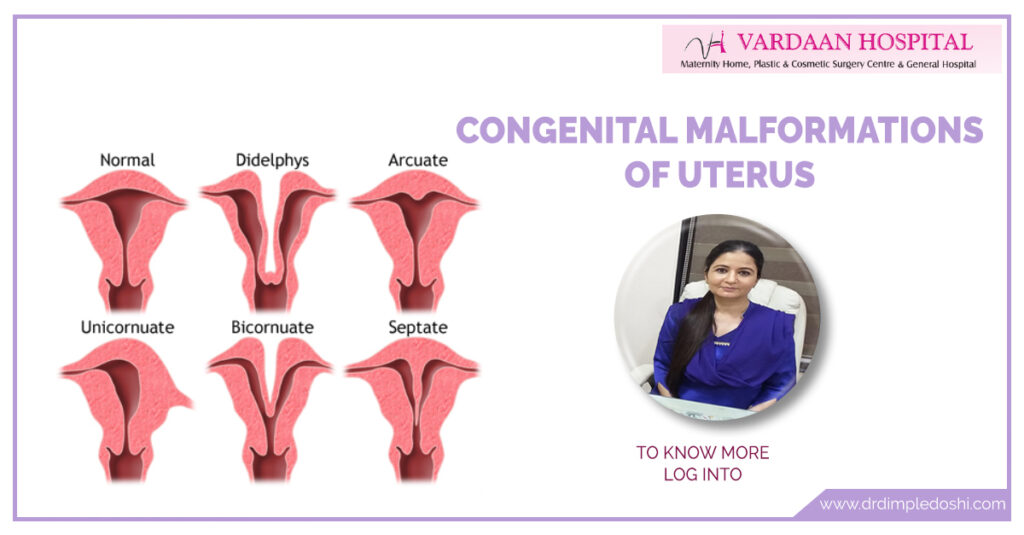Treatment for Congenital Uterine Malformations in Goregaon West, Mumbai
Congenital Malformation of Uterus
Introduction
Safe surgical interventions ensure optimal outcomes for congenital uterine anomalies. Expert evaluation guides effective treatments.
Congenital uterine anomalies are malformations affecting uterine development, leading to potential reproductive challenges and health issues in women.
Many women are born with an abnormally shaped uterus which is responsible for the symptoms like menstrual abnormalities; infertility; recurrent pregnancy loss; pain etc.
ICD-10 Codes for Congenital Malformation of the Uterus:
Congenital malformations of the uterus can include various types of structural abnormalities. Relevant ICD-10 codes are:
- Q51.0: Uterus didelphys (a double uterus)
- Q51.1: Septate uterus (a uterus with a septum dividing it)
- Q51.2: Bicornuate uterus (a uterus with two horns)
- Q51.3: Unicornuate uterus (a uterus with only one horn)
- Q51.4: Mullerian agenesis or hypoplasia (underdeveloped or absent uterus)
- Q51.8: Other congenital malformations of the uterus
- Q51.9: Congenital malformation of the uterus, unspecified
CPT Codes for Diagnosis and Treatment of Congenital Malformation of the Uterus:
Diagnosis and treatment may involve various procedures:
- 58100: Endometrial biopsy (for diagnostic purposes if malformation affects the endometrium)
- 58558: Hysteroscopy, surgical; with sampling (biopsy) of endometrium and/or polypectomy, with or without D&C (for diagnosing and treating abnormalities)
- 58561: Hysteroscopy, surgical; with resection of uterine septum (specific for septate uterus)
- 58562: Hysteroscopy, surgical; with endometrial ablation (may be used in some cases to treat associated bleeding)
- 58720: Salpingo-oophorectomy (if part of a more extensive surgical treatment plan)

Dr. Dimple Doshi at Vardaan Hospital; believes prevention is better than cure, and thus apart from the precise treatment guidelines; preventive measures are an essential part of our consultations with the patients who have either had it or want to know more about it.
Types of Congenital Malformation of Uterus
ASRM ( American Society of Reproductive Medicines ) classification is as follows:
Class 1: Absent uterus
Uterus is absent or very small and unerdeveloped; vagina is also absent. It is also called MRKH syndrome .
Class 2: Unicornuate uterus or one sided uterus.
It forms due to half development of the uterus and appears typically like banana in imaging studies.
Class 3: Uterus didephys or double uterus
It forms due to failure of the fusion of mullerian ducts causing double uteri; double cervix and vaginal partition.
Class 4 : Bicornuate uterus
It forms due to failure of fusion of the upper part of mullerian system; leading to bifurcation of the upper part of the uterus.
Class 5: Septate uterus
It forms when the mullerian ducts fuse but the partition between them is still present. Thus splitting the the uterus. And this may include the cervix and vagina as well.
Usually the septum involve the upper part of the uterus and is a frequent cause of miscarriages.
Class 6: T shaped uterus
The inner cavity of the uterus in T shaped.
Another variant is arcuate uterus where there is a concave dimple at the top of the uterus called the fundus.
Rudimentary or undeveloped uterus or the remnant of the uterus may be found in the abdomen with these anomalies.
Many times patients with uterine anomalies have abnormalities of the kidney also.
Diagnosis of Congenital Abnormalities of the Uterus:
- Physical examination
- Ultrasongraphy
- Pelvic MRI
- HSG or hysterosalpingography
- Hysteroscopy
- Laparoscopy
Treatment of Abnormally Shaped Uterus
The most commonly seen abnormalities of the uterus are:
1.Septate uterus
2.Arcuate uterus
3.T shaped uterus
All these abnormalities can be corrected by hysteroscopy namely; hysteroscopic septal resection; hysteroscopic septal division; and metroplasty .
The advantage of a hysteroscopic surgery is that it does not involve staying admitted in the hospital and you can be discharged on the same day. And it does not involve any stitches.
Davydov S Vaginoplasty
- Davydov s vaginoplasty is a procedure done by laparoscopy and it is meant to develop new vagina in patients with MRKH syndrome in whom the uterus and vagina are either absent or maybe a very small undeveloped uterus.

